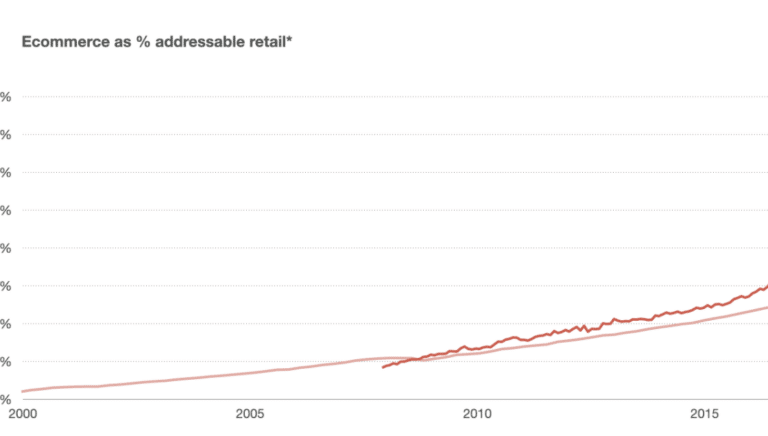In this post, I will highlight some of the history around mobile marketing, the challenges marketers face with their existing marketing tech stack, the key components of the modern marketing stack, examples of brands that are knocking it out of the park, and how you should look to architect yours.
What is Mobile Marketing – A Short History
Years before there was even a thing called mobile marketing, people began texting in the mid-’90s when SMS (short message service) was introduced into Nokia phones. It wasn’t until the early 2000’s when the first marketing SMS with advertisements was sent by a Finnish news provider. Mobile apps, although very basic at the beginning, emerged as a way to connect your device to a multitude of services. First with schedule and other organiser type apps on the Psion Series 3 Personal Digital Assistant (PDA), and then onto the handwriting recognition capabilities of the unsuccessful Apple Newton PDA, and then onto the popular PalmPilots. When the Nokia 6110 was launched, we got addicted to the snake game, Memory and Logic (all pre-installed apps). Fast forward to 2008, things really began to really change in mobile when Steve Jobs introduced the App Store to the world. This is where you could, for the first time, safely download little packages of software onto your mobile phone. Within 1 week, 10 million apps had been downloaded, and within 60 days that had shot up to 100 million.
Today, mobile apps are now downloaded hundreds of billions of times each year, and are fundamentally established in our lives as the connective glue and digital storefront to a huge amount of services, communities, networks and brands.
At Branch, we summarise mobile marketing as any marketing activity that aims to acquire, convert and engage users across a multi-channel mobile ecosystem that results in an exchange of value, whilst maximising ROI, and lifetime value.
Accelerating Mobile Consumer Behavior
As consumer behaviours and technology have evolved since those early days, mobile marketing has gone from being a very small part of the marketing mix to the core focus for mobile-first companies, or in a growing number of cases, the sole focus for mobile-only or app-only companies.
As Ben Evans points out in this excellent post, the headline numbers are pretty dramatic. The UK went from 20% e-commerce penetration to over 30% in two months, and the USA from 17% to 22%. Ben does highlight that once lockdown eases it still remains unclear what exactly will stick and what won’t. Whatever happens, agility and the ability to experiment in the months ahead is going to be critical.
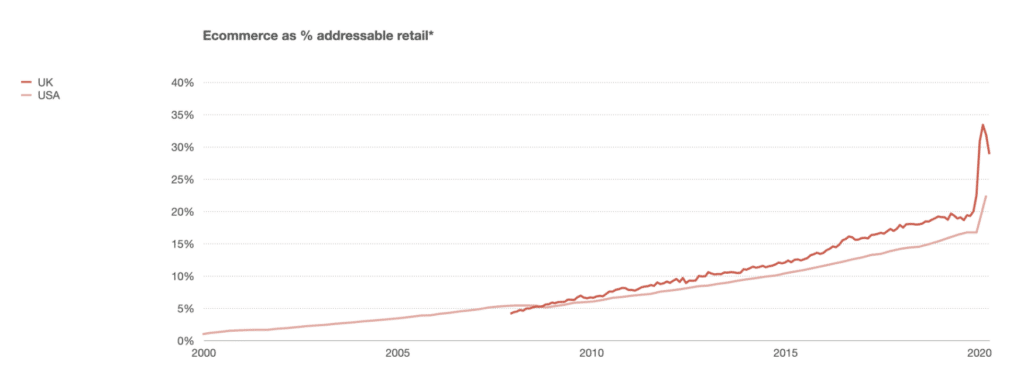
McKinsey also recently released a survey that highlights that there is between a 15-30% growth in consumers purchasing online post-COVID-19. Interestingly, these habits seem like they’re going to stick as US consumers report an intent to shop online even after the COVID-19 crisis.
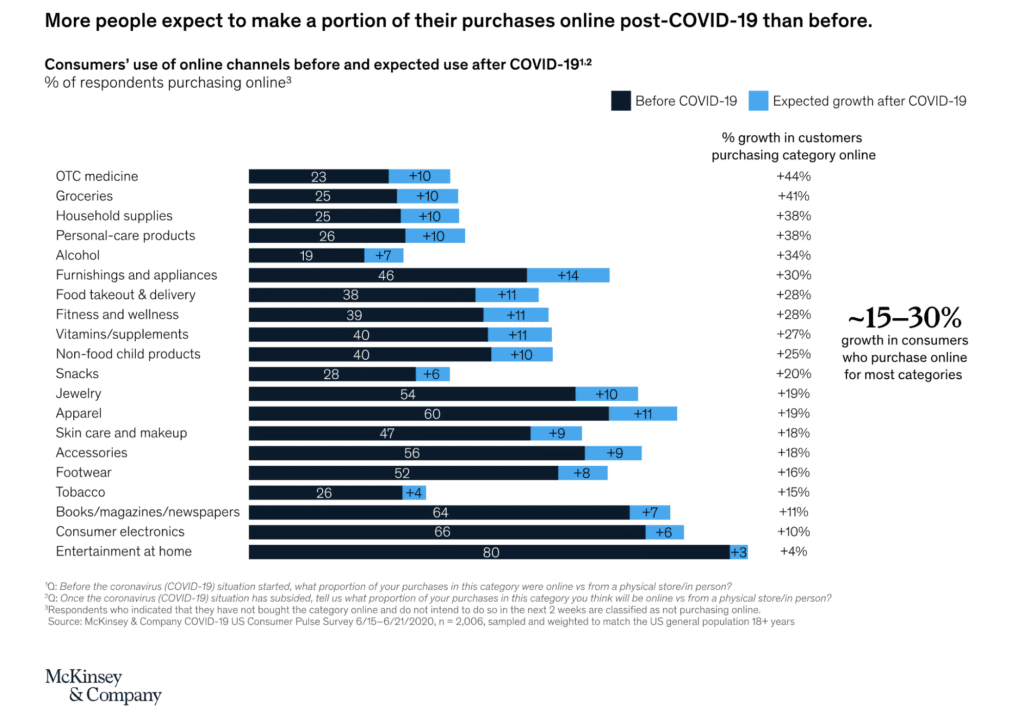
Smartphones and mobile apps are now an essential part of our life that make our daily tasks like shopping and eating more convenient, makes us feel more connected to friends and family, and for health and safety reasons, more and more people are adopting mobile apps and adapting to other technologies like QR codes.
According to an eMarketer study, since last year the average time that a US person spends on their phone each day has jumped 13.9%.
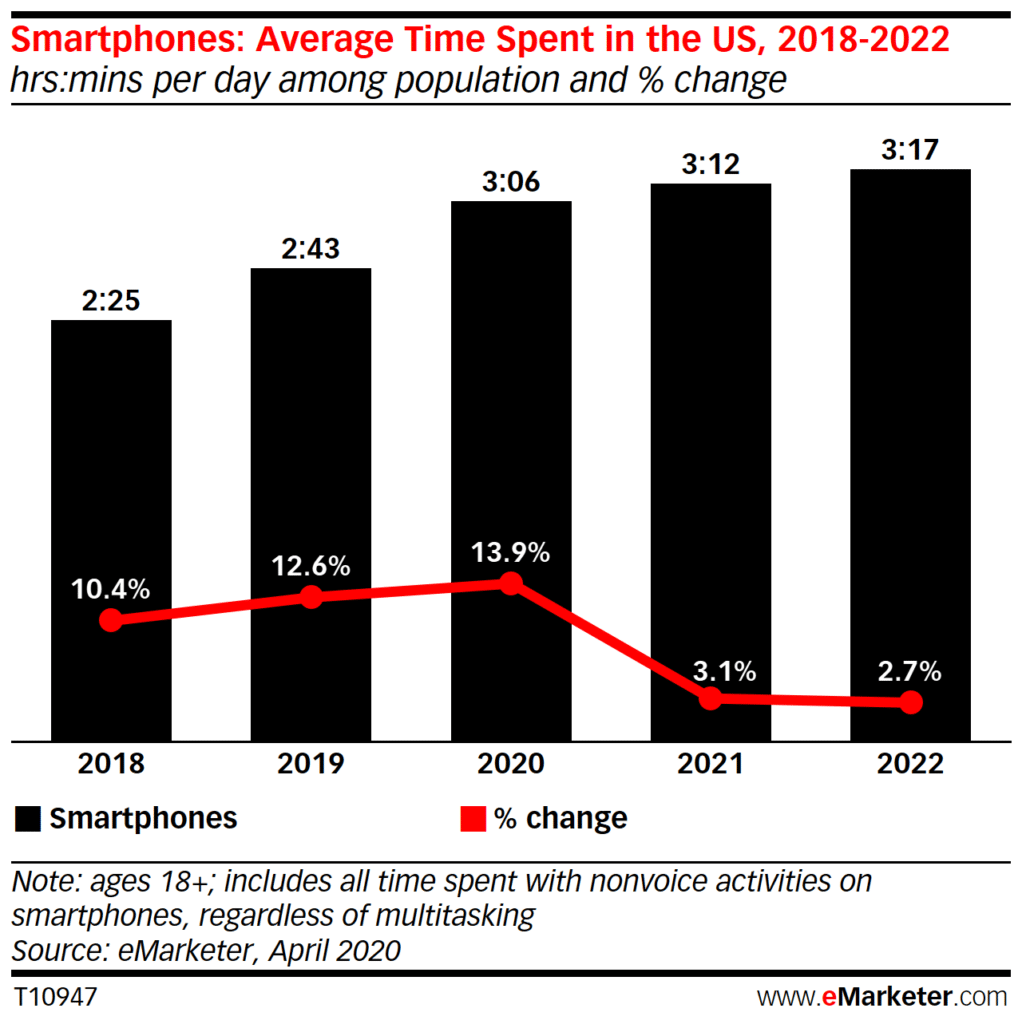
In the Dscout’s Mobile Touches Report, the average smartphone user will tap, swipe, click their smartphone 2,617 times, while the top 10% of users will do this a whopping 5,427 times a day. That is almost 2 million touches per year.
With smartphone adoption and connected devices at an all-time high, and as the change in consumer behaviours accelerates, the modern marketer needs to ensure that their martech stack gives them the business agility and insights to experiment with new ideas and campaigns.
An Overview of the 2020 Marketing Landscape
Scott Brinker highlights in his excellent graphic that the martech landscape is incredibly bloated, and even in the last year, the number of maretech solutions increased by 13.6%, to a total of 8,000. In the coming year, I would expect an increase in churn and consolidation through merger and acquisition activity, but also a lot of innovation and new solutions to appear as the mobile ecosystem is going through some pretty fundamental changes.
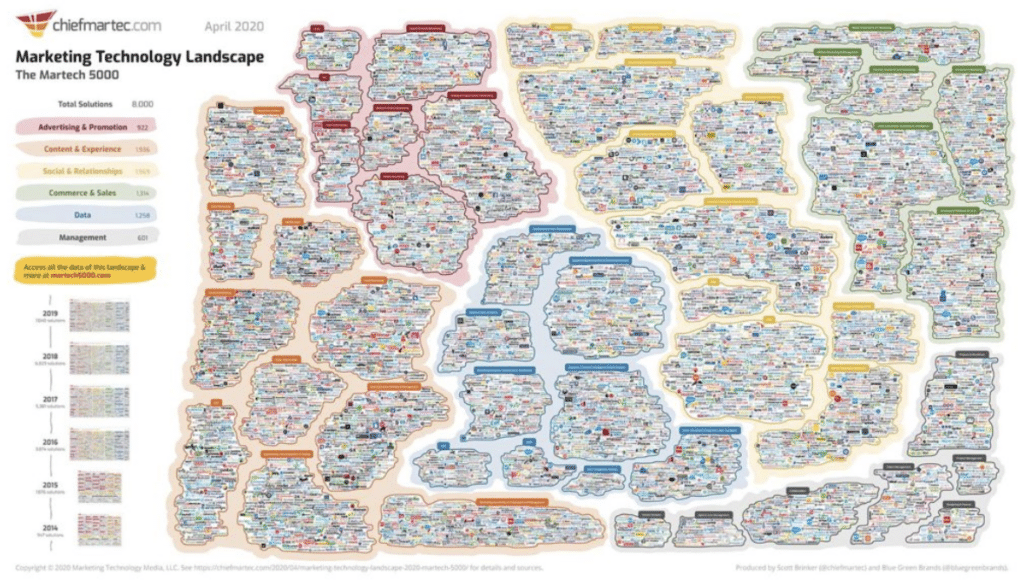
Martech Shifts and Challenges
Once-upon-a-time, mobile equaled an easy, consolidated problem to solve with incremental features offered by traditional marketing platforms. Especially now with COVID-19, mobile IS marketing for many companies, which means an all-in-one tool just isn’t the answer anymore. Mobile marketing today is far more fast-moving, complex, and nuanced, and it is time to pick best-in-class solutions to solve specific problems.
Keeping up with today’s mobile-centric consumers is no longer a “nice to have” for brands. Rather, it is essential that they have a mobile marketing tech stack that is customizable to their evolving business and customer needs, and that it plays nicely together with other solutions.
One of the biggest challenges to having the necessary business agility is when companies take the decision to use a single integrated suite of martech solutions compared to a considered selection of best-in-class marketing solutions that meet their requirements and today’s customer expectations.
There is still a surprising percentage of companies working with an integrated vendor — in a Gartner survey, they found that the tide is changing with 56% of US/UK martech buyers preferring to go with best-of-breed solutions. Not surprisingly, they found that best-of-breed martech also outperforms integrated suites — 48% of buyers reported that their stack meets current business needs, compared to just 27% of integrated suite buyers.
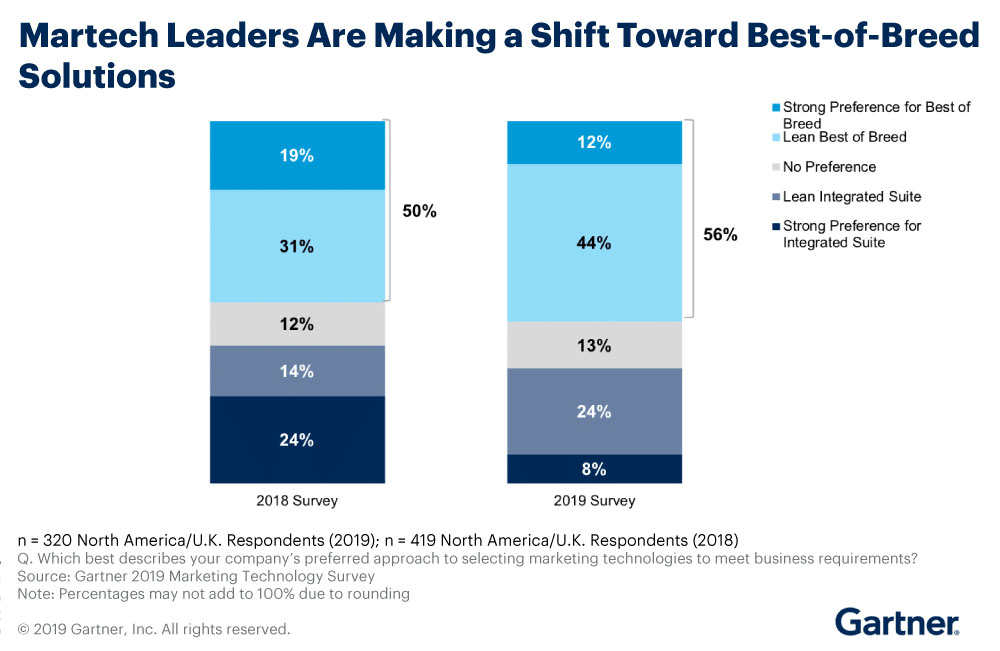
Even with the companies that adopt best-of-breed solutions, only 48% of the Marketing teams are getting their needs met, which is a lot of untapped potential and businesses effectively leaving money on the table when it comes to not leveraging their investment.
Alongside any tech investment, particularly marketing tech, it is only when marketing teams hire and invest in the right talent, provide the necessary time and space to train their teams in the latest technology and methodologies, and truly partner with their technology providers will they be able to fully realise their investments.
At Branch, we always strive to have a productive and successful working relationship with our customers, and through our dedicated Professional Services, Customer Success and Support teams, along with Branch University, we do our utmost to ensure that our customers are getting the very best results from their investment in Branch.
A Breakdown Of The Modern Mobile Marketing Tech Stack
Any mention of a mobile stack needs to reference one of the first frameworks and visualisations of the space, i.e. Mobile Growth Stack by Andy Carvell.
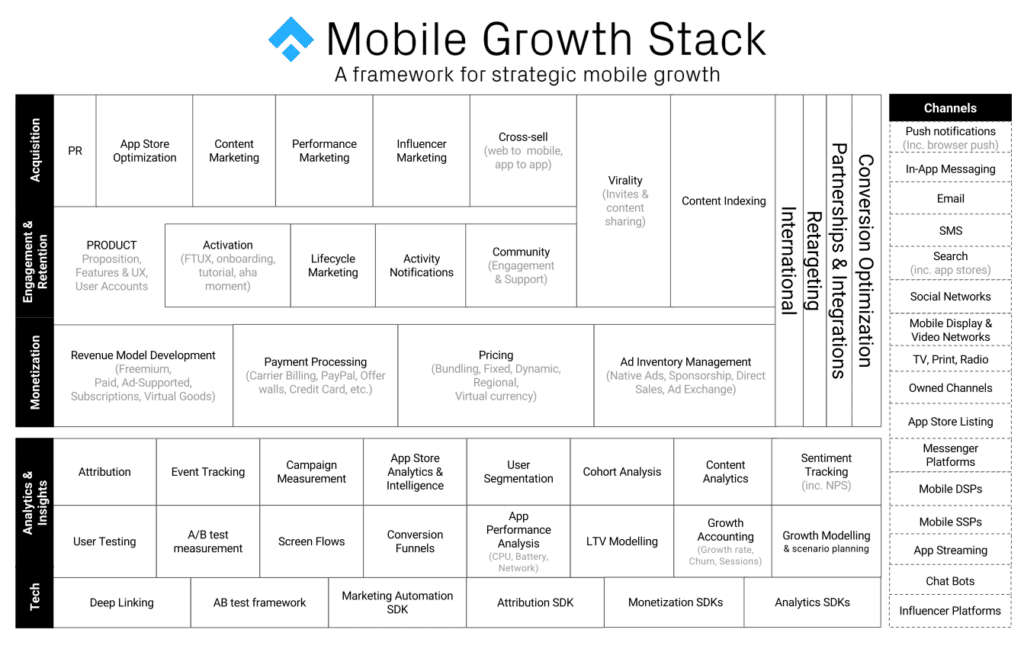
Whilst a few years old now, it remains an excellent representation when looking at a framework for strategic mobile growth and one that I would highly recommend that you check out if you haven’t already.
Companies that don’t align their marketing strategy with their tech stack and continue to add in the next shiny niche vendor without due consideration and planning will eventually bloat their tech stack. This will increase tech debt, and has the consequence of slowing down your ability to execute and experiment. Your team size will need to increase to cope (or else burn out), and there will be more overlap, an increase in silos, and your team will understandably struggle to keep up to date with all the features that your tech stack could provide. Not a great place to be in when the world around you is moving faster each day.
Our top recommendations are to focus on the following:
- Hiring the best talent with the right skills, experience, and mindset.
- Keep your martech stack lean and mean —select modern, open, and complementary solutions that are proven to work well together.
- Align your business goals with hiring and marketing strategy, and optimize your initiatives around that.
Whilst Branch leaves the hiring of talent to our customers, when it comes to strategy and keeping the mobile tech stack lean and mean, we are certainly part of the conversation where our customers look to us for insights, ideas, strategies, and best practices on what we have seen work across the fastest growing and most innovative mobile first companies. We always take a genuinely consultative approach to really dig in and understand our customer’s business, challenges, and goals. Once we have taken the time to uncover that, only then will we tailor our recommendations for the specific situation.
This will always be a work in progress that will require teams to adopt a continuous improvement philosophy, however it is made easier by the choices of which technology you buy and the mindset of the team that you build.
In the table below, we have included the most important components that you need to consider when building your stack, and some of the key players in those categories. We have included a mix of mobile-native solutions that integrate seamlessly with Branch, and legacy integrated solutions which are enhanced by working alongside Branch by making their tech stack more relevant.
| Component | Description | Key Players |
| Product Analytics | In-app user behaviour analytics – identify where in the app is performing well or where the app needs to be improved. Used primarily by Product Managers but also Marketers. Product Analytic providers allow you to optimize user conversion, retention and engagement. This helps you get to a deeper understanding of user behaviour throughout the journey that enables your product team to deliver a product that maximises your customers LTV. |
Adobe, Amplitude, mixpanel, Optimizely, Taplytics, Appsee, Firebase. |
| Deep Linking | With the mobile ecosystem fragmented, including walled gardens surrounding the major platforms, having the ability to link consumer journeys together to enable unbroken experiences from search, email, mobile web, social etc into the app is expected by today’s customers. Branch gives you peace of mind that your links will work in every edgecase to route users to the best destination with the industry’s highest matching accuracy, by combining every deep linking standard into a single, simple package. Easy to implement, and always up to date. |
Branch, Firebase |
| Mobile Attribution | Mobile attribution provides you with visibility into all your marketing activities and the ability to connect touchpoints from every channel and platform. Branch’s matching technology is designed specifically for the world where universal identifiers such as IDFA and GAID don’t exist. The Branch system uses an industry-unique, anonymous, predictive algorithm that incorporates historical attributions to deliver high accuracy attribution where there is no universal ID. This means where the rest of the industry is reliant on basic probabilistic modeling with accuracy rates of 60-70%, Branch can deliver superior, more accurate attributions. |
Branch, Adjust, AppsFlyer, Kochava, Singular |
| Marketing Automation | Design, build, test, and implement orchestrated customer engagement (content and message-driven interactions) across all channels to your users at the right time via email, SMS, push and in-app messaging. Used to engage or reengage with your users. | Iterable, Airship, Leanplum, OneSignal, Braze, Moveable Ink, batch, Localytics, Sailthru, Adobe Campaign, Oracle Responsys, Salesforce, Swrve, Iterable |
| Customer Data Platforms | Establish standards and connectivity that enables the stack to speak the same language, understand and action off of customer interactions in real-time. | Segment, mParticle, exponea, Adobe AEP |
| Data Warehouse | Your database that combines the different data points from across your marketing systems. |
Snowflake, Amazon, Azure, Google Big Query |
| Business Intelligence and Data Visualisation | These platforms help you visually stitch together all the data from your attribution provider, product analytics, CDP, and mobile automation provider into one central interface for all stakeholders to see your mobile performance and help your organisation optimize performance. This also helps garner buy-in to our growth strategies and cross-departmental collaboration and decision making. | Tableau, Amplitude, Looker |
| Location Awareness Platforms/Geofencing | Platforms that allow companies to build location-aware experiences. | Radar, Foursquare Pilgrim SDK, bluedot |
*Branch uniquely integrates at a deep level with all of the key players and many, many more.
Examples of Companies Winning with Modern Marketing Stacks
Pomelo Fashion is a digital-first eCommerce company that places a lot of emphasis on data and experimentation, and as such, they have chosen to partner with a handful of the best-of-breed technologies.

Pomelo has Branch at the core of its stack, and leverages our deep linking and cross channel attribution capabilities. Branch is plugged into Segment, which is used for data management and event tracking. Braze completes the trio as the CRM platform. The platforms are all integrated with each other and finally Pomelo uses Looker for data visualisation.
You can find a very insightful post from Pomelo’s CMO Jean Thomas where he talks about how he works with tech partners and their culture of experimentation and continuous improvement to enhance their customers’ experience.
A Detour to Win
Another epic example of the modern mobile marketing tech stack is the award-winning Burger King Detour campaign where you could order a Whopper for 1 cent from a McDonald’s location. This is a great example of a brand leveraging technology to enable a creative vision and business strategy. The agency FCB NY had the original creative idea behind the campaign, which is pure genius, and in terms of the key pillars of the tech stack this is what it looked like:
- Tillster: for mobile order and payment.
- mParticle: CDP used to orchestrate data between the BK app and other CRM partners.
- Radar: Geofencing used for unlocking, allowing BK to tag all McD’s in the USA.
- Braze: CRM vendor used to send push, e-mail, and in-app messages.
- Branch: Linking platform used to make it easier to get to BK App.
- Amplitude: Analytics tool used to calculate redemptions, measure behavior, and target messages.
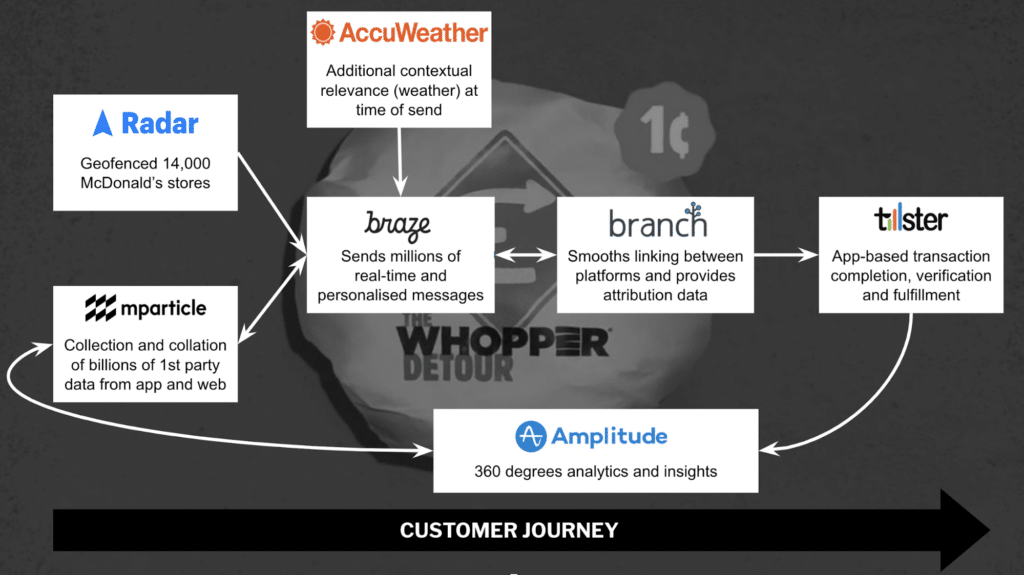
The results: 2.5 billion impressions, 1.5 million downloads of the BK app in the U.S., and a total sales value of 3x during the promotion. The Whopper Detour campaign also put the BK mobile app on the map, making people engage with it and continue to use it. The ROI for the campaign was a flaming hot 37:1.
Conclusion
In summary, we believe that the time for marketers to have an agile, modern stack is here, and companies that don’t have this agility will only fall behind.
As you can see in the Burger King example above, the right technology can combine and enable creativity to be executed in new innovative ways to have huge business impacts, but without the right ideas, people and processes, you’ll quickly come unstuck.
Once you have the strategy locked in to maximise the required business and technology agility, make sure you have the best talent you can find, and then identify and leverage the right technology partners who will really help you accelerate towards your goals.
| On a slightly different theme but related note, here at Branch we are fortunate to work with the world’s most innovative mobile-first companies to specifically solve the unique challenge of delivering mobile adoption and growth at breakneck speed. I am proud to work for this company and our partners on a fantastic initiative to make the modern mobile marketing tech stack completely free to early-stage startups led by Black founders. Today, only 1% of founders backed by venture capital in the United States are Black. Branch has come together to partner with the fastest-growing SaaS products that help companies capture and act on customer data to accelerate their growth. Capabilities offered in this stack span data collection, attribution, analytics, and engagement from (Branch, Braze, mParticle, Amplitude, Radar) with strong native integrations that are often implemented and used together by mobile-first businesses to achieve growth and outsized business impact. Check out this page for more details and how to apply: https://branch.io/tech-for-black-founders/ |






















